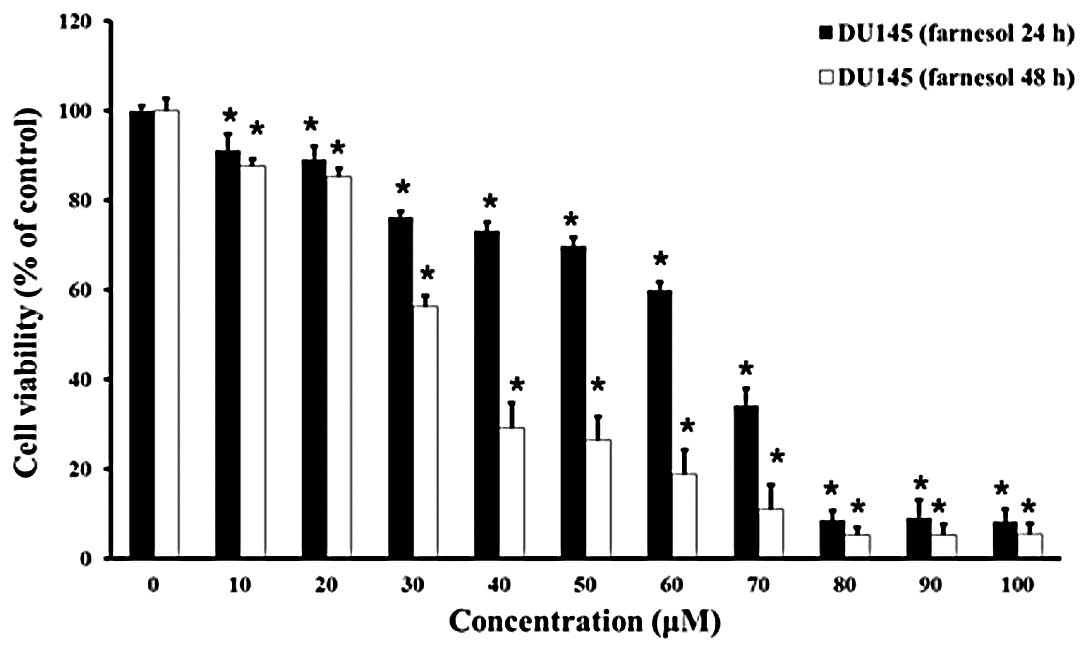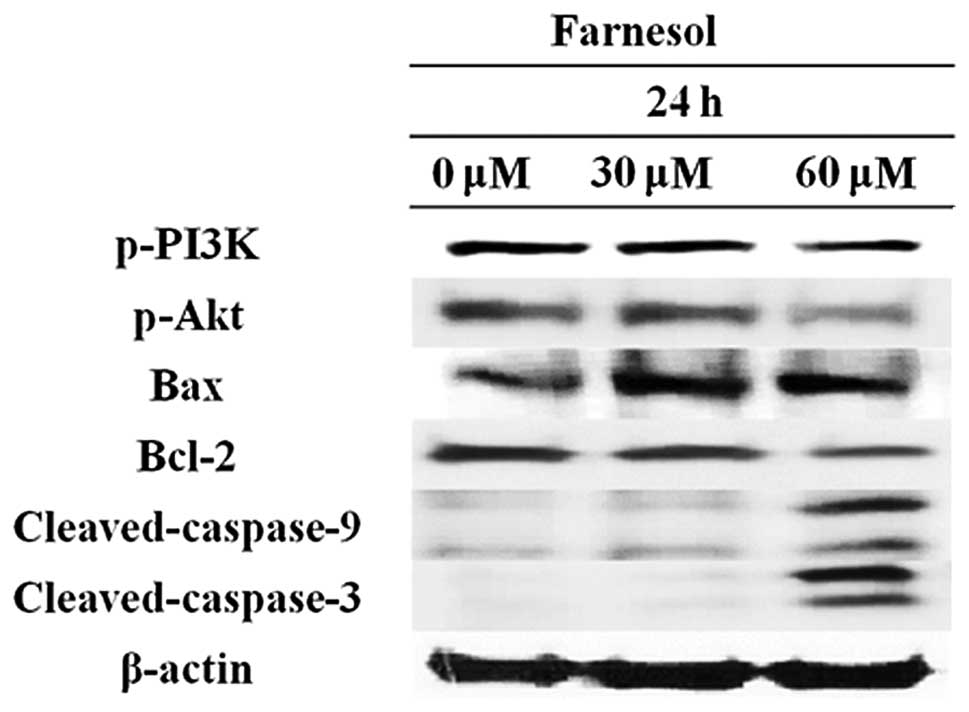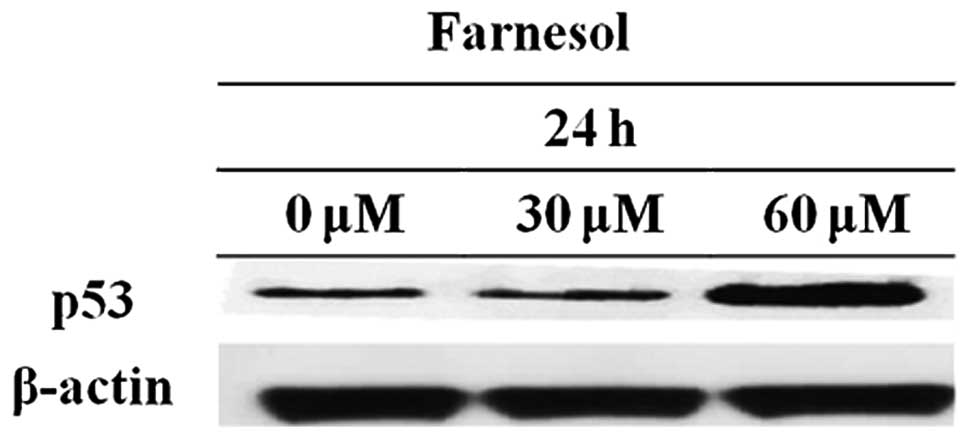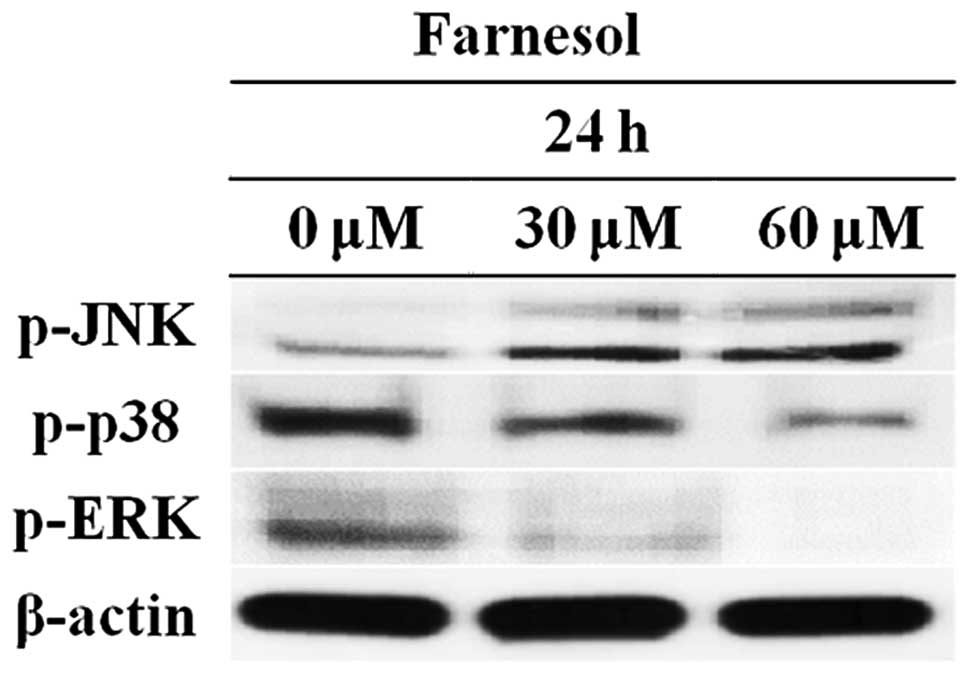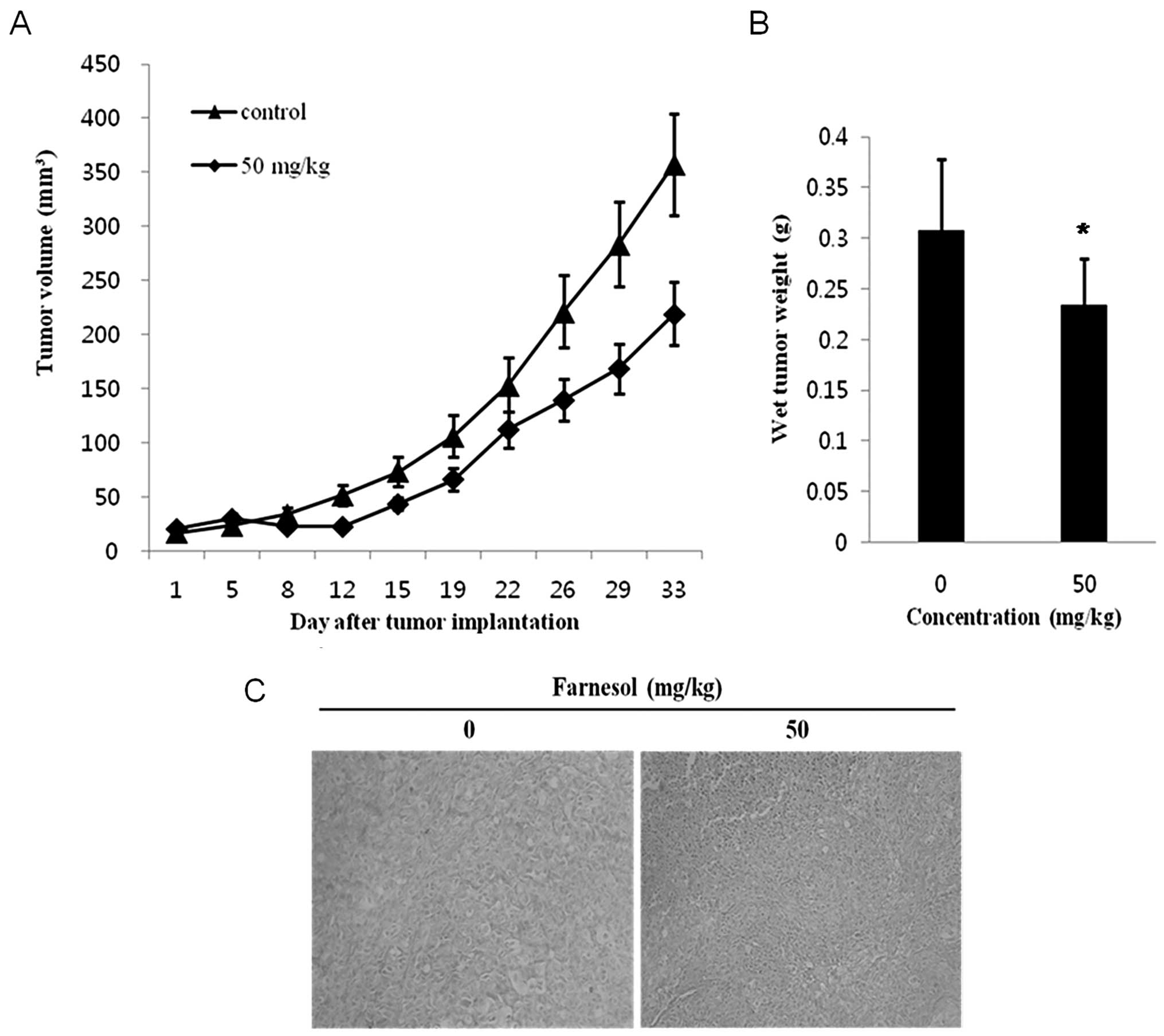|
1
|
Cohen LA: Nutrition and prostate cancer: a
review. Ann NY Acad Sci. 963:148–155. 2002. View Article : Google Scholar : PubMed/NCBI
|
|
2
|
Kim EJ, Lim SS, Park SY, et al: Apoptosis
of DU145 human prostate cancer cells induced by dehydrocostus
lactone isolated from the root of Saussurea lappa. Food Chem
Toxicol. 46:3651–3658. 2008. View Article : Google Scholar : PubMed/NCBI
|
|
3
|
Jain G, Voogdt C, Tobias A, et al: IκB
kinases modulate the activity of the androgen receptor in prostate
carcinoma cell lines. Neoplasia. 14:178–189. 2012.
|
|
4
|
Hellerstedt BA and Pienta KJ: The current
state of hormonal therapy for prostate cancer. CA Cancer J Clin.
52:154–179. 2002. View Article : Google Scholar : PubMed/NCBI
|
|
5
|
Siegel R, Naishadham D and Jemal A: Cancer
statistics, 2012. CA Cancer J Clin. 62:10–29. 2012. View Article : Google Scholar
|
|
6
|
Rowan S, Rachet B, Alexe DM, et al:
Survival from prostate cancer in England and Wales up to 2001. Br J
Cancer. 99(Suppl 1): S55–S57. 2008. View Article : Google Scholar
|
|
7
|
Spitz MR, Strom SS, Yamamura Y, et al:
Epidemiologic determinants of clinically relevant prostate cancer.
Int J Cancer. 89:259–264. 2000. View Article : Google Scholar : PubMed/NCBI
|
|
8
|
Bostwick DG and Qian J: Effect of androgen
deprivation therapy on prostatic intraepithelial neoplasia.
Urology. 58(Suppl 1): S91–S93. 2001. View Article : Google Scholar
|
|
9
|
Ezekwudo D, Shashidharamurthy R, Devineni
D, et al: Inhibition of expression of anti-apoptotic protein Bcl-2
and induction of cell death in radioresistant human prostate
adenocarcinoma cell line (PC-3) by methyl jasmonate. Cancer Lett.
270:277–285. 2008. View Article : Google Scholar : PubMed/NCBI
|
|
10
|
Feldman BJ and Feldman D: The development
of androgen-independent prostate cancer. Nat Rev Cancer. 1:34–45.
2001. View
Article : Google Scholar : PubMed/NCBI
|
|
11
|
Jemal A, Siegel R, Ward E, et al: Cancer
statistics, 2008. CA Cancer J Clin. 58:71–96. 2008. View Article : Google Scholar
|
|
12
|
Akao Y, Kusakabe S, Banno Y, et al:
Ceramide accumulation is independent of camptothecin-induced
apoptosis in prostate cancer LNCaP cells. Biochem Biophys Res
Commun. 294:363–370. 2002. View Article : Google Scholar : PubMed/NCBI
|
|
13
|
Akao Y, Banno Y, Nakagawa Y, et al: High
expression of sphingosine kinase 1 and S1P receptors in
chemotherapy-resistant prostate cancer PC3 cells and their
camptothecin-induced up-regulation. Biochem Biophys Res Commun.
342:1284–1290. 2006. View Article : Google Scholar : PubMed/NCBI
|
|
14
|
Rabi T and Bishayee A: d-Limonene
sensitizes docetaxel-induced cytotoxicity in human prostate cancer
cells: Generation of reactive oxygen species and induction of
apoptosis. J Carcinog. 8:92009. View Article : Google Scholar
|
|
15
|
Hanley K, Kömüves LG, Ng DC, et al:
Farnesol stimulates differentiation in epidermal keratinocytes via
PPARalpha. J Biol Chem. 275:11484–11491. 2000. View Article : Google Scholar : PubMed/NCBI
|
|
16
|
Rioja A, Pizzey AR, Marson CM and Thomas
NS: Preferential induction of apoptosis of leukaemic cells by
farnesol. FEBS Lett. 467:291–295. 2000. View Article : Google Scholar : PubMed/NCBI
|
|
17
|
Bifulco M: Role of the isoprenoid pathway
in ras transforming activity, cytoskeleton organization, cell
proliferation and apoptosis. Life Sci. 77:1740–1749. 2005.
View Article : Google Scholar : PubMed/NCBI
|
|
18
|
Miquel K, Pradines A and Favre G: Farnesol
and geranylgeraniol induce actin cytoskeleton disorganization and
apoptosis in A549 lung adenocarcinoma cells. Biochem Biophys Res
Commun. 225:869–876. 1996. View Article : Google Scholar
|
|
19
|
Wright MM, Henneberry AL, Lagace TA, et
al: Uncoupling farnesol-induced apoptosis from its inhibition of
phosphatidylcholine synthesis. J Biol Chem. 276:25254–25261. 2001.
View Article : Google Scholar
|
|
20
|
McTaggart SJ: Isoprenylated proteins. Cell
Mol Life Sci. 63:255–267. 2006. View Article : Google Scholar
|
|
21
|
Ong TP, Heidor R, de Conti A, et al:
Farnesol and geraniol chemopreventive activities during the initial
phases of hepatocarcinogenesis involve similar actions on cell
proliferation and DNA damage, but distinct actions on apoptosis,
plasma cholesterol and HMGCoA reductase. Carcinogenesis.
27:1194–1203. 2006. View Article : Google Scholar
|
|
22
|
Goldstein JL and Brown MS: Regulation of
the mevalonate pathway. Nature. 343:425–430. 1990. View Article : Google Scholar : PubMed/NCBI
|
|
23
|
Edwards PA and Ericsson J: Sterols and
isoprenoids: signaling molecules derived from the cholesterol
biosynthetic pathway. Annu Rev Biochem. 68:157–185. 1999.
View Article : Google Scholar : PubMed/NCBI
|
|
24
|
Miquel K, Pradines A, Tercé F, Selmi S and
Favre G: Competitive inhibition of choline phosphotransferase by
geranylgeraniol and farnesol inhibits phosphatidylcholine synthesis
and induces apoptosis in human lung adenocarcinoma A549 cells. J
Biol Chem. 273:26179–26186. 1998. View Article : Google Scholar
|
|
25
|
Burke YD, Stark MJ, Roach SL, et al:
Inhibition of pancreatic cancer growth by the dietary isoprenoids
farnesol and geraniol. Lipids. 32:151–156. 1997. View Article : Google Scholar
|
|
26
|
Crowell PL: Prevention and therapy of
cancer by dietary monoterpenes. J Nutr. 129:S775–S778.
1999.PubMed/NCBI
|
|
27
|
Chagas CE, Vieira A, Ong TP and Moreno FS:
Farnesol inhibits cell proliferation and induces apoptosis after
partial hepatectomy in rats. Acta Cir Bras. 24:377–382. 2009.
View Article : Google Scholar : PubMed/NCBI
|
|
28
|
Bharate SB, Bhutani KK, Khan SI, et al:
Biomimetic synthesis, antimicrobial, antileishmanial and
antimalarial activities of euglobals and their analogues. Bioorg
Med Chem. 14:1750–1760. 2006. View Article : Google Scholar
|
|
29
|
Katsuyama M, Ichikawa H, Ogawa S and
Ikezawa Z: A novel method to control the balance of skin
microflora. Part 1 Attack on biofilm of Staphylococcus
aureus without antibiotics. J Dermatol Sci. 38:197–205. 2005.
View Article : Google Scholar
|
|
30
|
McAnally JA, Jung M and Mo H:
Farnesyl-O-acetylhydroquinone and geranyl-O-acetylhydroquinone
suppress the proliferation of murine B16 melanoma cells, human
prostate and colon adenocarcinoma cells, human lung carcinoma
cells, and human leukemia cells. Cancer Lett. 202:181–192. 2003.
View Article : Google Scholar
|
|
31
|
Burke YD, Ayoubi AS, Werner SR, et al:
Effects of the isoprenoids perillyl alcohol and farnesol on
apoptosis biomarkers in pancreatic cancer chemoprevention.
Anticancer Res. 22:3127–3134. 2002.
|
|
32
|
Tanida M, Niijima A, Shen J, et al:
Olfactory stimulation with scent of lavender oil affects autonomic
neurotransmission and blood pressure in rats. Neurosci Lett.
398:155–160. 2006. View Article : Google Scholar
|
|
33
|
Kikuzaki H and Nakatani N: Antioxidant
effects of some ginger constituents. J Food Sci. 58:1407–1410.
1993. View Article : Google Scholar
|
|
34
|
Duncan RE and Archer MC: Farnesol induces
thyroid hormone receptor (THR) beta1 but inhibits THR-mediated
signaling in MCF-7 human breast cancer cells. Biochem Biophys Res
Commun. 343:239–243. 2006. View Article : Google Scholar
|
|
35
|
Takahashi N, Kawada T, Goto T, et al: Dual
action of isoprenols from herbal medicines on both PPARgamma and
PPARalpha in 3T3-L1 adipocytes and HepG2 hepatocytes. FEBS Lett.
514:315–322. 2002. View Article : Google Scholar
|
|
36
|
Cantley LC: The phosphoinositide 3-kinase
pathway. Science. 296:1655–1657. 2002. View Article : Google Scholar : PubMed/NCBI
|
|
37
|
Luo J, Manning BD and Cantley LC:
Targeting the PI3K-Akt pathway in human cancer: rationale and
promise. Cancer Cell. 4:257–262. 2003. View Article : Google Scholar
|
|
38
|
Vivanco I and Sawyers CL: The
phosphatidylinositol 3-Kinase AKT pathway in human cancer. Nat Rev
Cancer. 2:489–501. 2002. View
Article : Google Scholar : PubMed/NCBI
|
|
39
|
Schlieman MG, Fahy BN, Ramsamooj R, et al:
Incidence, mechanism and prognostic value of activated Akt in
pancreas cancer. Br J Cancer. 89:2110–2115. 2003. View Article : Google Scholar : PubMed/NCBI
|
|
40
|
Yamamoto S, Tomita Y, Hoshida Y, et al:
Prognostic significance of activated Akt expression in pancreatic
ductal adenocarcinoma. Clin Cancer Res. 10:2846–2850. 2004.
View Article : Google Scholar : PubMed/NCBI
|
|
41
|
Chadha KS, Khoury T, Yu J, et al:
Activated Akt and Erk expression and survival after surgery in
pancreatic carcinoma. Ann Surg Oncol. 13:933–939. 2006. View Article : Google Scholar
|
|
42
|
Terakawa N, Kanamori Y and Yoshida S: Loss
of PTEN expression followed by Akt phosphorylation is a poor
prognostic factor for patients with endometrial cancer. Endocr
Relat Cancer. 10:203–208. 2003. View Article : Google Scholar
|
|
43
|
Ng SS, Tsao MS, Nicklee T and Hedley DW:
Wortmannin inhibits pkb/akt phosphorylation and promotes
gemcitabine antitumor activity in orthotopic human pancreatic
cancer xenografts in immunodeficient mice. Clin Cancer Res.
7:3269–3275. 2001.
|
|
44
|
Bondar VM, Sweeney-Gotsch B, Andreeff M,
et al: Inhibition of the phosphatidylinositol 3′-kinase-AKT pathway
induces apoptosis in pancreatic carcinoma cells in vitro and in
vivo. Mol Cancer Ther. 1:989–997. 2002.
|
|
45
|
Fahy BN, Schlieman M, Virudachalam S and
Bold RJ: Akt inhibition is associated with chemosensitisation in
the pancreatic cancer cell line MIA-PaCa-2. Br J Cancer.
89:391–397. 2003. View Article : Google Scholar : PubMed/NCBI
|
|
46
|
McCubrey JA, Lahair MM and Franklin RA:
Reactive oxygen species-induced activation of the MAP kinase
signaling pathways. Antioxid Redox Signal. 8:1775–1789. 2006.
View Article : Google Scholar : PubMed/NCBI
|
|
47
|
Kholodenko BN and Birtwistle MR:
Four-dimensional dynamics of MAPK information processing systems.
Wiley Interdiscip Rev Syst Biol Med. 1:28–44. 2009. View Article : Google Scholar : PubMed/NCBI
|
|
48
|
Liu X, Li Q, Dowdell K, et al:
Varicella-Zoster virus ORF12 protein triggers phosphorylation of
ERK1/2 and inhibits apoptosis. J Virol. 86:3143–3151. 2012.
View Article : Google Scholar : PubMed/NCBI
|
|
49
|
Junttila MR, Li SP and Westermarck J:
Phosphatase-mediated crosstalk between MAPK signaling pathways in
the regulation of cell survival. FASEB J. 22:954–965. 2008.
View Article : Google Scholar : PubMed/NCBI
|
|
50
|
El-Deiry WS, Harper JW, O’Connor PM, et
al: WAF1/CIP1 is induced in p53-mediated G1 arrest and apoptosis.
Cancer Res. 54:1169–1174. 1994.PubMed/NCBI
|
|
51
|
Dulić V, Kaufmann WK, Wilson SJ, et al:
p53-dependent inhibition of cyclin-dependent kinase activities in
human fibroblasts during radiation-induced G1 arrest. Cell.
76:1013–1023. 1994.
|
|
52
|
Yonish-Rouach E, Resnitzky D, Lotem J, et
al: Wild-type p53 induces apoptosis of myeloid leukaemic cells that
is inhibited by interleukin-6. Nature. 352:345–347. 1991.
View Article : Google Scholar : PubMed/NCBI
|
|
53
|
Lowe SW, Schmitt EM, Smith SW, et al: p53
is required for radiation-induced apoptosis in mouse thymocytes.
Nature. 362:847–849. 1993. View Article : Google Scholar : PubMed/NCBI
|
|
54
|
Oda E, Ohki R, Murasawa H, et al: Noxa, a
BH3-only member of the Bcl-2 family and candidate mediator of
p53-induced apoptosis. Science. 288:1053–1058. 2000. View Article : Google Scholar : PubMed/NCBI
|
|
55
|
Nakano K and Vousden KH: PUMA, a novel
proapoptotic gene, is induced by p53. Mol Cell. 7:683–694. 2001.
View Article : Google Scholar : PubMed/NCBI
|
|
56
|
Sheu MJ, Chou PY, Huang CS, et al:
Pipoxolan inhibits proliferation of HL-60 human leukaemia cancer
cells by arresting the cell cycle at the G0/G1 phase. Clin Exp
Pharmacol Physiol. 37:605–612. 2010. View Article : Google Scholar
|
|
57
|
Benson RS, Heer S, Dive C and Watson AJ:
Characterization of cell volume loss in CEM-C7A cells during
dexamethasone-induced apoptosis. Am J Physiol. 270:C1190–C1203.
1996.
|
|
58
|
Allen RT, Hunter WJ and Agrawal DK:
Morphological and biochemical characterization and analysis of
apoptosis. J Pharmacol Toxicol Meth. 37:215–228. 1997. View Article : Google Scholar : PubMed/NCBI
|
|
59
|
Prives C and Hall PA: The p53 pathway. J
Pathol. 187:112–126. 1999. View Article : Google Scholar
|




